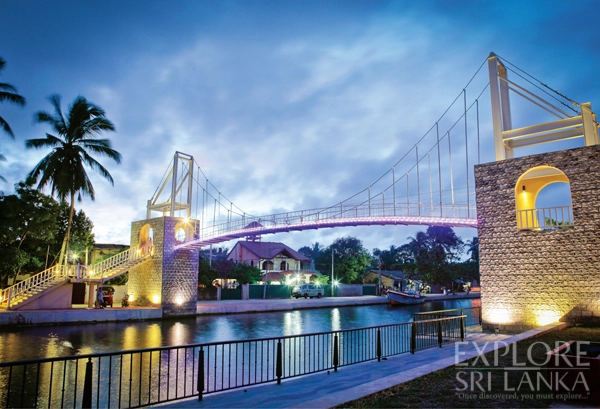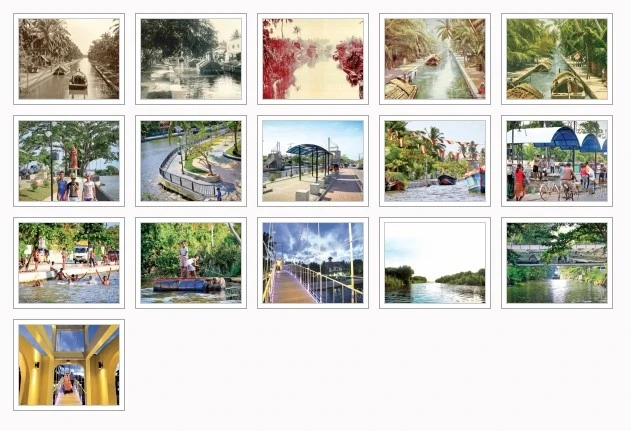
Sri Lanka’s remarkable canal legacy is due to the hydraulic expertise of the Island’s early civilisation and the homeland expertise of Dutch colonists. The British neglected canals for modern methods of shifting goods and carrying out trade – road and rail. Nevertheless, the important Hamilton Canal was constructed between Colombo and Negombo, which is now undergoing rehabilitation as an ecotourism destination.
Words Richard Boyle Photographs Menaka Aravinda and Indika De Silva
The history of Sri Lanka’s canals, including irrigation channels, is inevitably a complex one considering the depth of the hydraulic heritage. Where the western region is concerned, historical focus is on the linkage of canals with lagoons and rivers, which led to the possibility of travelling from Galle to Kalpitiya by water. “175 miles [280 km] of organised canal-traffic”, as Maturin Murray Ballou states in The Pearl of India (1894).
The first mention of the canals along the western seaboard was in the Eighth Century, when the illustrious Persian geographer, Abu Zayd Balki reported a voyage lasting weeks along the “Gobbs”, as the linked lagoons were referred to by Arabs. Here the mariners lived for months, apparently amidst flowers and overhanging woods, with abundant food and exhilarating draughts of arrack flavoured with honey.
Six centuries later the King of Kotte, Veera Parakramabahu VIII (1477- 1496), had a network of canals constructed connecting outlying villages with Colombo and Negombo Lagoon so that produce such as
arecanuts, cloves, cardamoms, pepper, and, most important of all, cinnamon, could be more easily transported to the kingdom’s main ports.
The interconnecting Colombo-Negombo canal was of great significance. Although generally called the “Dutch Canal”, the Netherlanders probably just repaired or deepened it, since in 1613, 27 years before their rule, Portuguese Father Manoel Barradas describes how “near Colombo the Fathers embarked on a Canal by which they entered the River Calane [Kelani Ganga], and going down the River they proceeded into another Canal as narrow and shady”; and so travelled to Negombo.
Between 1802 and 1804, when the Island was under British control, a new Colombo-Negombo canal was built, conceived by Garvin Hamilton, British Agent of Revenue and Commerce. Hamilton Canal ran west of the old Dutch Canal, quite close to the sea, from the mouth of the Kelani Ganga at Hekitta to the southern edge of the Negombo Lagoon at Pamunugama, a distance of 14.5 km.
Archive pictures confirm that distinctive padda-boats were the prime method of transportation. R L Brohier in Seeing Ceylon (1965) describes them as “large flat-bottomed boats or barges, square at both ends and with a steer both at bow and stern, so that the vessel’s passage through the water may be facilitated. Padda-boats are generally poled like a punt and are fitted at the stern with an outside oar serving as a rudder. They are often fitted with a removable cadjan roof sloping toward either side.”
Raven-Hart’s charming description of the Hamilton Canal echoed in my mind during a recent boat-ride from the southern end of the waterway to Negombo Lagoon
Such pictures expose the sheer beauty of the environment. Roland Raven-Hart opines in Ceylon: History in Stone (1964), “Canals are usually dull”. But he continues, “This one [the Hamilton] is really a river, at any rate at its northern part, and most attractive, fringed with lotus under palms and mangroves, alive with parakeets. It’s a charming tree-shaded waterway: coconut palms always lean to see their reflections, and here the film star [and lethally poisonous] Gloriosa Superba [Sinhala niyangala mal; Tamil kalaipai-kizhangu] was climbing the trunks in the same justified vanity.”
Raven-Hart’s charming description of the Hamilton Canal echoed in my mind during a recent boat-ride from the southern end of the waterway to Negombo Lagoon. The purpose was to witness the progress of the canal’s rehabilitation to improve the livelihood of the inhabitants of the area and to enhance its biodiversity as an ecotourism destination. The canal and its vicinity is of environmental importance as it is home to an astonishing number of species of fish, birds and plants.
The entire project covers not only the distance from the Kelani Ganga to Negombo Lagoon, but also the nine-kilometre stretch from Negombo town to the Maha Oya, which constituted the first stage. This ambitious project, which is spearheaded by Minister Basil Rajapaksa, under the Ministry of Economic Development’s Tourism Resources Development Programme, is being implemented by the Sri Lanka Land Reclamation and Development Corporation.
Entering the canal from the choppy, bridge-spanned estuary of the Kelani Ganga reveals a very different water-world. The mouth is wide, dominated on the right bank by a massive overhanging banyan tree and an imposing bronze statue of St Anthony, a reminder that this area is populated by many Roman Catholic fishermen, and that there are 15 churches hereabouts. Those days of transport, trade and exotic padda-boats are gone: today the canal is used chiefly to moor small and medium-sized fibreglass and wooden fishing boats that go to sea via the Kelani Ganga.
The rehabilitation of the canal is being executed in lengths of 2.5 km. The first, which runs through an urban environment, is now complete. What has been achieved is abundantly evident, the foremost example being a suspension bridge for pedestrians of eye-catching castle tower design, located within a short distance from the entrance to the canal. At night the alternating-colour ribbon lights that span the bridge reflect attractively in the still water of the canal and illuminate the activity of this bustling area.
Broad pavements – better described as walkways – which are punctuated by mature trees and newly planted saplings to provide future shade, have been imaginatively constructed using different materials, different colours, and different layouts. In addition, decoration has been added: depictions of sailing ships and sea creatures for example. Furthermore, one section overhangs the canal with expansive slabs of glass paving through which the water can be observed.
An appropriate facility is a new fish market located at the edge of the canal, where the cuttlefish, prawns and numerous fish are assured to be freshly caught. These are aspects that must be experienced on foot, but my narrative has to return to the perspective of the canal waters, which, incidentally, flow back and forth every twelve hours due to the influence of the sea-tide on the level of the water in the estuary.
The journey northwards encompassing the first rehabilitated stretch and beyond provides a varied experience determined by how populated the area is…
The journey northwards encompassing the first rehabilitated stretch and beyond provides a varied experience determined by how populated the area is. Along the rehabilitated stretch, the life of the community can be observed while on the water fishermen work on their boats and nets, and in it small boys frolic: the latter an activity much safer now the canal’s former pollution has been eliminated. And there are vital bridges over which the inhabitants pass where ferries once prevailed: four foot bridges and nine main bridges in a dilapidated condition are being repaired. Some display evocative paintings of the past, almost inevitably symbolised by the padda-boat.
Beyond, where coconut and spreading trees start to overhang the canal, can be seen fundamental rehabilitation. To combat the problem of embankment erosion, and increase biodiversity, the planting of trees has been initiated along the ecologically rich aquatic-terrestrial interface. A newly introduced bioengineering methodology employs a common local material, coir. It’s used as a blanket in wire mesh blocks containing rubble to provide a protective lining for the root systems of trees such as kumbuk and karanda, as well as bushes. These blocks are then joined to create what’s called a “gabion wall” at the canal’s edge to provide a ‘nursery’ for the trees to eventually flourish. Another approach is to roll coir blankets into logs and lay several together along the embankment.
Mangroves and other flora, including medicinal plants, abound, as do birds, fish, and butterflies…
Raven-Hart was correct when he wrote that the canal “is really a river, at any rate at its northern part” for the boat’s wake laps onto a shore in some parts, and there are some mysterious jungle enshrouded creeks. It’s thinly populated, with only an occasional wooden hut glimpsed through the embankment foliage. A dog comes to the shore and barks lustily. We are intruders in his canal, his domain.
Soon the Mudiyansage Ela (canal) is encountered, which flows inland and connects with the Dutch Canal. It also traverses the Muthurajawela Visitor Centre that serves the renowned marshes – a brackish coastal ecosystem that is biologically diverse – which is presently inaccessible by road. But soon the Mudiyansage Ela will be upgraded so that visitors can travel by boat to this unique destination. Mangroves and other flora, including medicinal plants, abound, as do birds, fish, and butterflies, even the occasional crocodile and python.
Eventually the canal enters the Negombo Lagoon, and while it was tempting to explore another water-world, the necessary return meant another opportunity to absorb the major influences of the journey, reflect on what has been achieved, and imagine the eventual completion of the rehabilitated Hamilton Canal, the future waterway.



